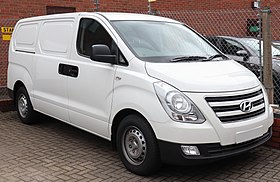
Back هيونداي ستاريكس Arabic Hyundai H-1 Danish Hyundai H-1 German Hyundai H-1 Spanish هیوندای استارکس Persian Hyundai Satellite French Hyundai H-1 ID Hyundai H-1 Italian ヒュンダイ・スタレックス Japanese 현대 스타렉스 Korean
This article has multiple issues. Please help improve it or discuss these issues on the talk page. (Learn how and when to remove these messages)
|
| Hyundai Starex | |
|---|---|
 | |
| Overview | |
| Manufacturer | Hyundai |
| Also called | Hyundai H-1 |
| Production | 1997 – March 2021 (South Korea) 1997–2023 (international) |
| Assembly | South Korea: Ulsan (Hyundai Motor Company Ulsan plant) Egypt: Cairo (Ghabbour Group) Algeria: Tiaret (TMC Group) Indonesia: Bekasi (HIM) Malaysia: Rawang, Selangor (Hyundai Malaysia) Turkey: Izmit (Hyundai Assan Otomotiv)[1] |
| Body and chassis | |
| Class | LCV (M): |
| Body style | 4-door van 4-door minibus 2-door pickup (Libero) |
| Layout | Front-engine, rear-wheel-drive Front-engine, four-wheel-drive |
| Chronology | |
| Predecessor | Hyundai Grace (Mitsubishi Motors) |
| Successor | Hyundai Staria Hyundai Solati H350 (Mexico) Hyundai ST1 (Libero) |
The Hyundai Starex (Korean: 현대 스타렉스) is a series of light commercial vehicles built by Hyundai. The first-generation models were known in Europe as Hyundai H-1, and in the Netherlands as Hyundai H200. The cargo variant of the second-generation models was marketed as the Hyundai iLoad in Australia and the United Kingdom. The second-generation passenger variant was marketed as the Hyundai iMax in Australia, and as the Hyundai i800 in the United Kingdom. In Europe, the cargo variant was marketed as the Hyundai H-1 Cargo, while the passenger variant was marketed as the Hyundai H-1 Travel. In the Netherlands, it is called the Hyundai H300. In Malaysia, the passenger variant of the H300 is only sold as a fleet vehicle, and the cargo variant is marketed as the Hyundai Starex Royale in a Minivan configuration.
- ^ "Hyundai. Hyundai In Turkey". Car-cat.com. Archived from the original on 2019-03-27. Retrieved 2010-10-08.